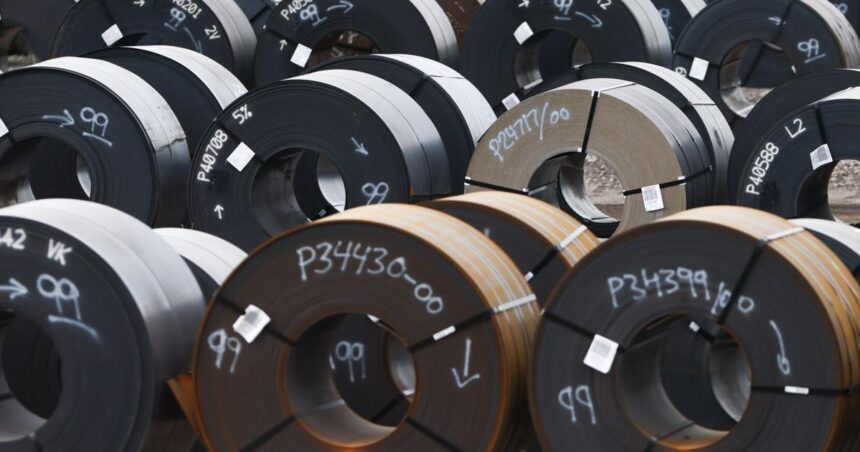It was just after 3 p.m. when Mark Carney stepped into Hamilton’s United Steelworkers Local 1005 hall yesterday. The room, filled with anxious faces of workers whose livelihoods hang in the balance, fell quiet as Canada’s former central bank governor – now a key Liberal cabinet minister – prepared to deliver news many had been waiting weeks to hear.
“We stand with you,” Carney told the crowd, unveiling a $380 million support package aimed at shielding Canadian steel producers and workers from the harsh impact of American tariffs. “This isn’t just about economics. It’s about communities, families, and the backbone of Canadian manufacturing.”
The announcement comes barely a month after President Trump reimposed steep 25 percent tariffs on Canadian steel, citing nebulous “national security concerns” that have left many trade experts puzzled and the industry reeling.
For Melissa Tompkins, a third-generation steelworker at Stelco’s Lake Erie Works, the announcement brought cautious relief. “My grandfather started here in 1952. My father worked 37 years. Now it’s me wondering if I’ll be the last,” she told me after the announcement. “At least now we have something to work with.”
The federal package includes $210 million in direct wage subsidies to prevent layoffs, $95 million for green technology retrofits at steel mills, and $75 million in export development assistance to help producers find markets beyond the United States. The government has earmarked the remaining funds for workforce training programs in communities heavily dependent on steel production.
Carney, who left his role at the Bank of England to enter Canadian politics last year, emphasized this isn’t simply a bandage solution. “We’re building resilience into the sector,” he said. “These measures will help our steel industry weather this storm while becoming more competitive globally.”
Steel has long been considered the backbone of Canadian manufacturing. The industry directly employs over 23,000 Canadians and supports roughly 100,000 indirect jobs, according to Statistics Canada. The sector contributes approximately $3.9 billion annually to Canada’s GDP.
But Hamilton, Sault Ste. Marie, and other steel towns have faced waves of uncertainty as trade tensions with our largest trading partner have ebbed and flowed. The Trump administration’s first round of steel tariffs in 2018 sent shockwaves through these communities before they were lifted in 2019.
Ken Neumann, Canadian director of the United Steelworkers union, offered measured praise for the package. “This gives our members breathing room, but we need permanent solutions to American protectionism,” he said. “The reality is we’re dealing with an unpredictable trade environment that could last years.”
The aid package notably skirts WTO rules against direct industry subsidies by focusing on workers and green technology rather than production assistance. Trade lawyers I’ve spoken with suggest this careful structuring should help Canada avoid triggering additional trade disputes.
At Dofasco’s plant entrance this morning, shift workers expressed mixed reactions. “It helps, sure, but it doesn’t solve the real problem,” said Martin Chen, a 14-year employee. “The Americans still have a 25 percent advantage selling into their own market, and that’s huge.”
The announcement came just hours after Deputy Prime Minister Chrystia Freeland returned from Washington, where talks with U.S. Trade Representative Katherine Tai apparently yielded little movement on the tariff issue. Sources familiar with the discussions told me the Americans remain entrenched in their position, despite Canadian arguments that the two countries’ steel industries are deeply integrated.
Polling suggests the steel tariffs have become a political liability for the Trudeau government. An Abacus Data survey released Tuesday found 63 percent of Canadians believe the government hasn’t done enough to protect manufacturing jobs from foreign trade pressures.
Conservative Leader Pierre Poilievre was quick to criticize the package as “too little, too late,” while calling for retaliatory tariffs against American products. “This government waited weeks while workers suffered,” Poilievre told reporters in Ottawa. “And now they’re offering pennies on the dollar compared to what the industry is losing.”
But trade experts caution against escalation. “Retaliatory tariffs might feel good, but they typically harm both countries,” explained Meredith Lilly, the Simon Reisman Chair in International Affairs at Carleton University. “Support for affected workers while pursuing diplomatic solutions is usually the more effective approach.”
Carney’s announcement also included a commitment to expedite anti-dumping cases against low-cost steel imports from other countries that might try to redirect products originally bound for the U.S. market into Canada – a problem that emerged during the previous round of tariffs.
Back in Hamilton, where smokestacks have defined the skyline for generations, there’s a sense that something fundamental is shifting. Steel towns have weathered many storms, but the combination of trade pressures, decarbonization demands, and global competition has created unprecedented challenges.
At Wimpy’s Diner on Ottawa Street, where steelworkers often gather for breakfast before shifts, the mood this morning was one of cautious hope. “We’ve been through tough times before,” said server Donna McPherson, who has worked at the diner for 19 years. “But the mills always kept going somehow. We need them to keep going.”
The true test of Carney’s aid package will come in the next few months, as companies make decisions about production levels, staffing, and investment. ArcelorMittal Dofasco has already paused a portion of its $1.8 billion green steel transition project, citing uncertainty created by the tariffs.
As the sun set over Hamilton Harbour last evening, casting long shadows from the mills that have defined this city for generations, the question hanging in the air wasn’t just whether this aid package would be enough – but whether Canadian steel can find a sustainable path forward in an increasingly unpredictable global trade environment.






